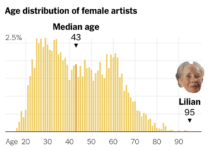Julia Janicki, Daisy Chung, and Joyce Chou explore Taiwan’s aging population, where in 2021, pets outnumbered children. I like the experimental views in this piece. More of this please.
Tags: age, population, Taiwan Data Stories
Adam's Blogroll: click through to the author's blog
Saloni Dattani, for Our World in Data, used a set of heatmaps to show how causes of death changed by time (on the horizontal axis) and age (on the vertical axis) in France. Each panel represents a cause category.
The code is on GitHub, in case you want to make similar charts for your own country.
Tags: age, mortality, Our World in Data
Posted by in age, mortality, Our World in Data, Statistical Visualization
The world is getting older overall. For The New York Times, Lauren Leatherby broke it down by country with a set of animated frequency trails, along with charts for more demographic shifts. I like it.
Tags: age, New York Times, population, world
Posted by in age, New York Times, population, Statistical Visualization, world
For FiveThirtyEight, Geoffrey Skelley digs into the ongoing trend:
What’s behind these increasingly older Congresses? The country’s aging population as a whole is chiefly responsible, which is most apparent in the disproportionate influence the baby boomer generation has on Capitol Hill. Coupled with longer-running trends that have made it more likely for members of Congress to win reelection and stick around, this has all helped make Congress older than ever before. And the overrepresentation of boomers doesn’t just produce moments like those of the TikTok hearings — it also has real effects on the type of policies passed by the federal legislature.
Tags: age, Congress, FiveThirtyEight
Posted by in age, congress, FiveThirtyEight, Statistical Visualization
 Tom Brady, the quarterback for the Tampa Bay Buccaneers, is 45 years old, which makes him the oldest player in the National Football League. Francesca Paris, for NYT’s The Upshot, places Brady’s age under the perspective of other occupations. For example, Lilian Thomas Burwell, who is an artist at 95 years old, is well in the upper percentile for those in her field (and the general population).
Tom Brady, the quarterback for the Tampa Bay Buccaneers, is 45 years old, which makes him the oldest player in the National Football League. Francesca Paris, for NYT’s The Upshot, places Brady’s age under the perspective of other occupations. For example, Lilian Thomas Burwell, who is an artist at 95 years old, is well in the upper percentile for those in her field (and the general population).
See also: the distributions of age and occupation.
Disney Research demonstrates their use of neural networks to seamlessly age and de-age someone’s face across a continuous range. Sure what is real anymore anyway.
Tags: age, Disney, face, neural network
Posted by in age, Disney, face, neural network, statistics
Annie Fu, Walt Hickey, and Shayanne Gal, for Insider, show the disproportionately aging government officials with a series of straightforward charts with lines moving up. You expect age across most occupations to increase with life expectancy, but this seems a bit much.
See also the aging distribution over time.
Tags: age, government, Insider
Posted by in age, government, Insider, Statistical Visualization
In 2017, a study posited that human behavior complexity peaks at age 25 and then declines, especially after age 60. The researchers estimated complexity through people’s ability to make up random patterns. Russell Goldenberg and Arjun Kakkar, for The Pudding, let you put the theory to the test and discuss why the original researcher’s findings were questionable.
Tags: age, Pudding, randomness
Posted by in age, Pudding, randomness, Statistical Visualization
Population.io by World Data Lab asks your birthday, country of residence, and gender. It spits out tidbits comparing your age to the rest of the world population, such as how old you are compared to others and how many people you might share a birthday with. Fun.
It also provides a few back-of-the-napkin calculations for life expectancy based on averages, with maybe a bit too much certainty for your expected date of death. For more uncertainty but more accuracy for what is known, see also this look at mortality.
Tags: age, population, World Data Lab
Posted by in age, population, Statistical Visualization, World Data Lab
Bonnie Berkowitz and Artur Galocha go with the strip plot to show the distribution of age for different Olympic events. If it’s longevity you’re looking for, go for the equestrian, sailing, shooting, and archery events. There’s still time.
Tags: age, Olympics, Washington Post
Posted by in age, Olympics, Statistical Visualization, Washington Post